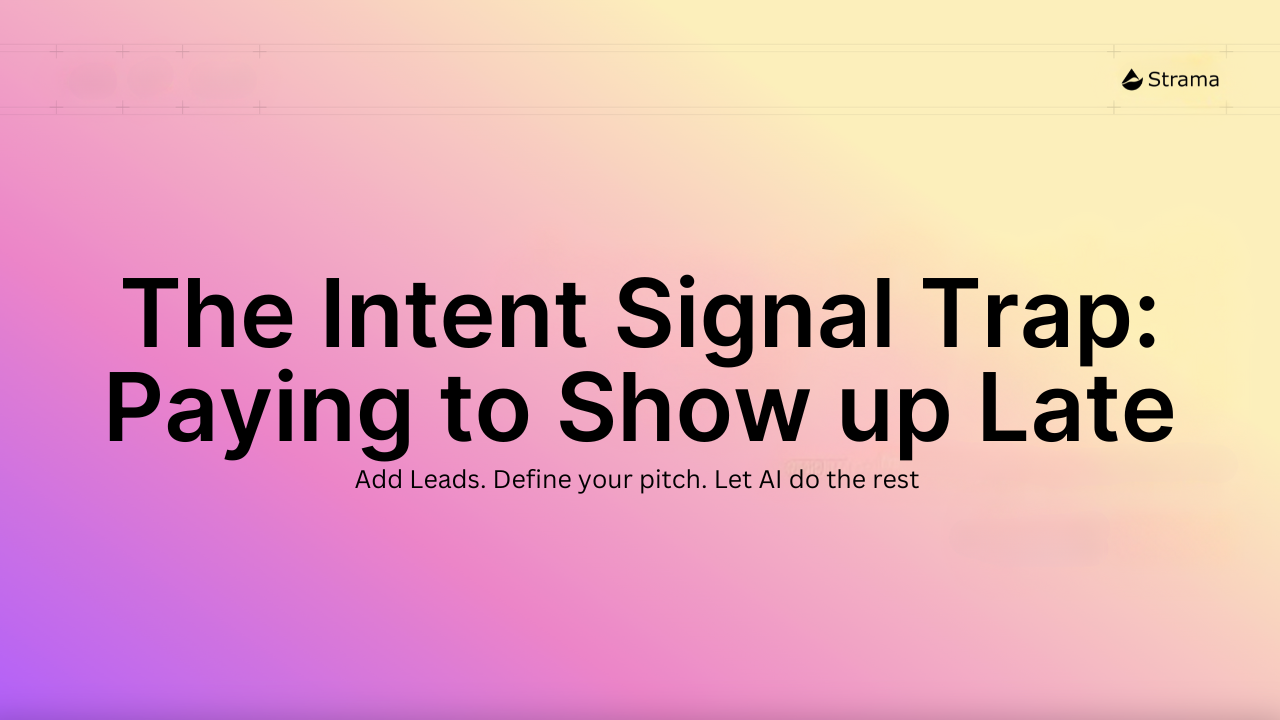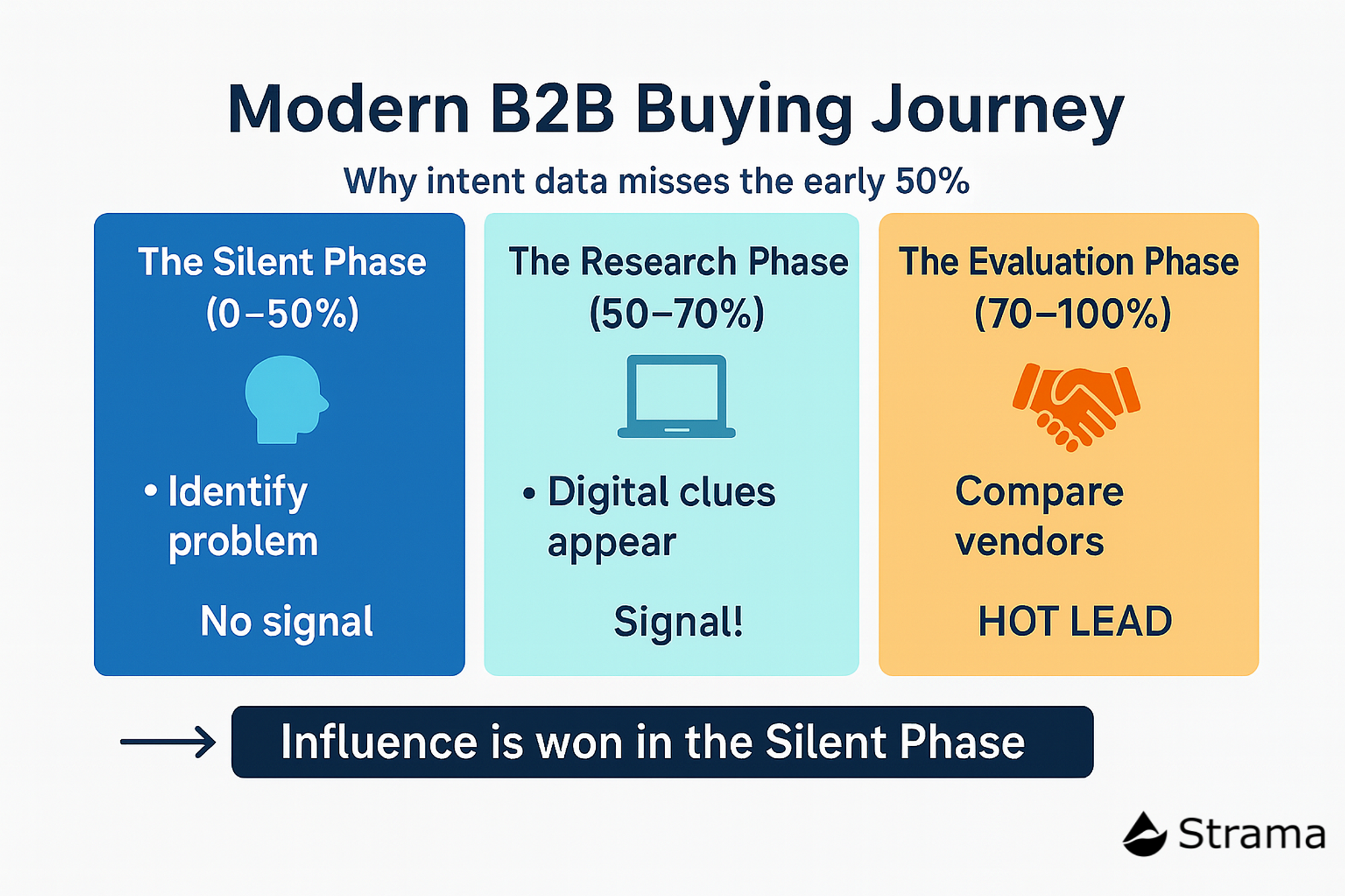Tuesday, July 8, 2025
The Intent Signal Trap: You're Paying to Show Up Late


A company recently shared their intent signal experiment with me. Six months. Hundreds of "high-intent" leads identified. Outreach to every single one.
Meetings booked? Zero.
The problem? By the time you see intent signals, someone else has already been shaping the buyer's thinking for months. You're not getting in early—you're playing catch-up.
The Intent Signal Gold Rush
Intent signals have become the latest must-have in B2B sales. The promise is intoxicating: Know exactly who's interested in buying, right when they're interested.
The data backs up why teams are obsessed. Only about 10% of your total addressable market is actively in-market at any given time ¹. Intent data promises to help you find that golden 10%.
But here's what the intent data vendors don't put in their pitch decks: Intent signals are often just expensive hindsight.
Why Intent Signals Are Like Watching Last Week's Game Film
Relying on intent means you're reacting, not creating pipeline. Think about what intent signals actually capture:
- Someone visited your pricing page (after researching 5 competitors)
- A company is "surging" on category keywords (deep in evaluation)
- Multiple people from the same company hit your site
By the time these signals fire, buyers are often 69% through their journey before ever engaging with a sales rep ². They've already formed opinions. In fact, some reports show a staggering 81% of buyers have already chosen their preferred vendor before initiating contact with sales ².
You're not early. You're barely on time. Sometimes, you're just late.
The Enterprise RFP Reality Check
Here's a painful example from my own experience. Working with enterprise customers, whenever I saw intent signals around specific search terms, I knew what was coming: an RFP.
But here's the kicker—by the time they were researching those terms, they were gathering data to support requirements someone else had already influenced. A competitor had shaped their thinking months earlier. The intent signal wasn't an opportunity; it was a notification that I'd already lost.
That's the modern B2B buying journey:

The Silent Phase (0-50%)
- Buyers identify problems internally
- Form preferences based on content, peers
- Your intent tools see: Nothing
The Research Phase (50-70%)
- Digital breadcrumbs appear
- Multiple stakeholders get involved
- Your intent tools see: "Hey, something's happening!"
The Evaluation Phase (70-100%)
- Active vendor comparison
- Decision criteria set
- Your intent tools see: "HOT LEAD!"
The problem? Most meaningful influence happens in that silent phase.
The Real Problems with Intent-Only Strategies
1. You're Always Playing Defense
When intent is your primary trigger, you're perpetually reacting. Competitors who engaged earlier have already shaped the buyer's criteria, built trust, and positioned their solution as the standard. You're the person showing up to a party that's already winding down.
2. Everyone Sees the Same Signals
If you're seeing Company X showing intent for "sales automation software," guess who else sees it? Every competitor with the same intent data. Result? A feeding frenzy. The prospect gets bombarded, and your outreach arrives alongside 10 other messages.
3. False Positives Are Expensive
That "surge in intent"? It could be an intern researching, a competitor snooping, or an existing customer looking for support. Third-party intent is especially noisy. For example, a "surge" signal often can't distinguish between a single intern reading one article and a 15-person buying committee actively evaluating solutions ³. Chasing every signal burns resources fast.
4. You Miss the Other 90%
An intent-only strategy ignores the vast majority of your market who could become future pipeline. By waiting for signals, you miss the chance to shape their problem definition, build early relationships, and create demand rather than just capture it.
The Smarter Way: Intent as Intelligence, Not Trigger
Here's how the smartest teams use intent signals:
1. Layer Intent with Proactive Outreach
Use intent to prioritize, not initiate. Already doing outbound? When those accounts show intent, accelerate—don't start.
2. Combine Signals for Context
One signal is noise. Multiple signals are music. Look for first-party + third-party alignment, multiple stakeholders from the same account, progression over time, and a match between intent signals and your ideal customer profile.
3. Create Intent, Don't Just Chase It
The best teams manufacture intent through influential content, thought leadership, and category creation. They shape the conversation that eventually shows up as intent signals for others.
4. Speed Still Matters
If you do act on a high-value intent signal, act fast. You're nearly 7x more likely to have a meaningful conversation if you respond within the first hour ⁴.
The Bottom Line
Intent signals are like a metal detector at the beach. Useful? Absolutely. But if that's your only tool, you'll miss the treasure buried deeper.
Winners in modern B2B sales combine proactive outreach, thought leadership, buyer enablement, and use intent signals to identify acceleration opportunities.
Stop waiting for buyers to signal intent. Start creating the conditions that generate it. Because by the time the signal fires, the game might already be over.
Building Something Better at Strama
We believe intent signals have value—as one piece of a much bigger puzzle. That's why we're developing the next iteration of intent-assisted prospecting at Strama.
Our plan: Use intent for intelligence, not as a crutch. Combine signals with comprehensive research and proactive outreach to help teams get ahead of the buyer journey, not chase it.
We're looking for input. If you've been burned by intent-only strategies or have ideas on how to make intent data actually useful, we want to hear from you. Help us build something that plays offense, not defense.
Reach out at kevin@strama.ai
Sources
¹ 6sense, "About 10% of Your Potential Customers Are Ready to Buy Right Now," (blog).
[URL: https://6sense.com/blog/about-10-of-your-potential-customers-are-ready-to-buy-this-quarter-chances-are-youre-missing-them/]
² 6sense, "2024 Buyer Experience Report." Primary research showing buyers are 69% through their journey and 81% have chosen a vendor before engaging sales.
[URL: https://6sense.com/science-of-b2b/2024-buyer-experience-report/]
³ Clearbit, "How to Use Intent Signals," (resource guide). Discusses data quality challenges with third-party data (illustrative example).
[URL: https://clearbit.com/resources/guides/intent-data]
⁴ Harvard Business Review, "The Short Life of Online Sales Leads," (article). Study showing a nearly 7x higher likelihood of qualifying a lead when responding within one hour.
[URL: https://hbr.org/2011/03/the-short-life-of-online-sales-leads]